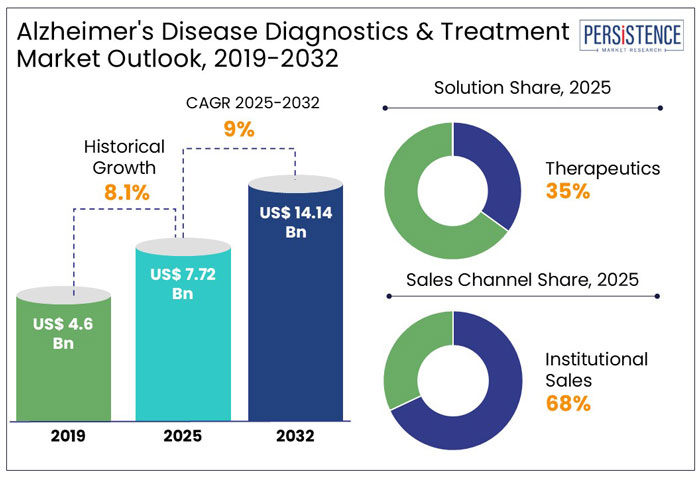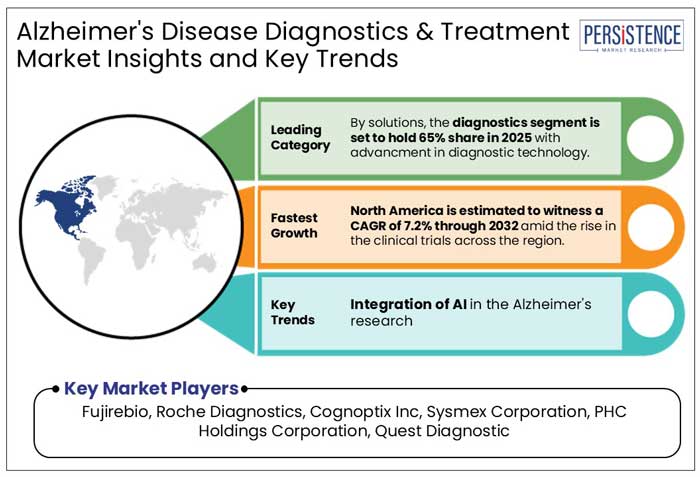Industry: Healthcare
Published Date: February-2025
Format: PPT*, PDF, EXCEL
Delivery Timelines: Contact Sales
Number of Pages: 188
Report ID: PMRREP33700
The global Alzheimer’s disease diagnostics and treatment market size is anticipated to rise from US$ 7.72 Bn in 2025 to US$ 14.14 Bn by 2032. It is projected to witness a CAGR of 9.0% from 2025 to 2032.
The surge in dementia cases across the globe is estimated to boost the advancement in diagnostics and treatment for the Alzheimer's disease in the forthcoming years.
Government and non-government organizations are investing heavily in diagnoses and treatments due to the increasing incidence of Alzheimer's disease worldwide, which might increase the demand for Alzheimer's disease treatments.

Key Highlights of the Alzheimer’s Disease Diagnostics and Treatment Market
|
Global Market Attributes |
Key Insights |
|
Alzheimer’s Disease Diagnostics and Treatment Market Size (2025E) |
US$ 7.72 Bn |
|
Market Value Forecast (2032F) |
US$ 14.14 Bn |
|
Projected Growth (CAGR 2025 to 2032) |
9.0% |
|
Historical Market Growth (CAGR 2019 to 2024) |
8.1% |
Limited Adoption of Therapeutics for Alzheimer’s in Pandemic Impacts Healthcare Industry
The global Alzheimer’s disease diagnostics and treatment industry witnessed a CAGR of 8.1% in the historical period between 2019 and 2024. The World Health Organization declared COVID-19 a public health emergency in January 2020, leading to significant disruptions in the global economy. These disruptions affected drug and vaccine production and caused financial impacts on businesses and markets.
Alzheimer's disease is becoming an increasingly pressing issue, with a projected short-term negative impact on diagnostic rates. As of 2021, approximately 50 million people worldwide are affected by Alzheimer's, with nearly 10 million new cases reported each year.
In the U.S., an estimated 6.5 million citizens aged 65 and older are living with Alzheimer's disease, with 73% of those individuals aged 75 or older.
Additionally, the adverse effects of lockdowns during the pandemic have had significant implications for the healthcare industry globally.
Innovation in Medical Imaging Technology to Boost Sales through 2032
In the estimated timeframe from 2025 to 2032, the global market for diagnostics and treatment for the Alzheimer's disease is likely to showcase a CAGR of 9.0%, according to Persistence Market Research. The precision and dependability of Alzheimer's diagnosis have increased thanks to sophisticated image analysis and quantification methods, such as volumetric analysis and machine learning algorithms.
Cerebrospinal fluid (CSF) assays, neuroimaging methods, and conventional cognitive tests are examples of current diagnostic tools that allow for early detection for successful treatment.
In June 2023, the FDA approved Roche's cerebrospinal fluid (CSF) test, which quantifies tau and beta-amyloid proteins.
Sales and demand for the global market of Alzheimer's diagnostics and treatments may increase due to these developments, which may also lead to the creation of more effective diagnostic tools and therapies.
Growth Drivers
Neuroimaging Technologies Enable Earlier and More Accurate Diagnosis
Neuroimaging technologies, such as PET scans with amyloid tracers, are improving the accuracy of diagnostics and driving market growth. Companies are expanding their product offerings and launching new products due to ongoing research in the healthcare industry.
The market for Alzheimer's disease diagnostics and therapeutics is expected to grow in tandem with various healthcare initiatives such as clinical trials and development in healthcare technology during the forecast period. For instance,
The development of improved Alzheimer's treatments aims to target disrupted lipid pathways while reducing amyloid beta and tau proteins, further driving the growth of the Alzheimer's drug market.
High Medical Expenses Limits the Adoption of Prevalent Therapeutics
The high cost of diagnosing Alzheimer's disease poses a significant barrier to growth in this field, as it incurs substantial economic and societal expenses for the healthcare system, individuals, families, and careers. The resources required to prevent, diagnose, treat, and manage dementia are considerable.
Studies indicate that both direct and indirect costs associated with Alzheimer’s disease-related healthcare are high, including expenses related to post-mortem brain tissue assessments using PET and CSF biomarkers, as well as innovative clinical criteria.
The cost of an accurate dementia diagnosis is calculated by dividing the total expenses of all investigative procedures by the number of confirmed diagnoses, utilizing unit costs for various diagnostic components.
Additionally, the global prevalence of Alzheimer's disease is projected to rise dramatically due to the aging population, which will increase costs and hinder the growth of the Alzheimer's diagnostics and therapeutics market during the forecast period.
Integration of AI Presents Promising Prospects for Innovation in Healthcare Industry
AI is transforming Alzheimer's research by analyzing MRI images and blood samples from patients across the world. Convolutional neural networks, vision transformers, and federated learning are some of the cutting-edge methods being used by healthcare institutions to forecast the course of diseases and spot early warning indicators.
AI's role in personalized treatment and drug discovery is promising, as it can help determine the most effective treatments for individuals based on their unique genetic and clinical profiles.
The consortium is now collaborating with pharmaceutical companies like Biogen to develop innovative imaging techniques that make it easier to track Alzheimer's progression and test new drugs.
The future of AI in Alzheimer's research is promising, with multimodal AI combining various types of medical data to improve diagnosis and treatment predictions.
Solution Insights
Advancements in Diagnostic Testing Promote Accurate and Reliable Tests for Alzheimer’s
Improvements in diagnostic technology are expected to enhance the accuracy and reliability of Alzheimer's diagnostic tests, leading to a market share of 65% of the global market for these diagnostics in 2025. This rise reflects an increasing demand for trustworthy diagnostic solutions.
Companies like Roche and Biogen are investing in innovative diagnostic methods, including cerebrospinal fluid biomarker tests, blood-based biomarker tests, computerized cognitive assessments, and brain imaging techniques. These advancements aim to improve early detection and treatment planning, thereby accelerating market expansion.
In addition, the senior population and the pressing need for efficient therapies that address the illness's underlying causes are driving the growth of the worldwide Alzheimer's disease research sector, with disease-modifying treatments predicted to account for 35% of the market in 2025.
Eli Lilly, for instance, is expanding its production capabilities with a US$ 1.8 Bn investment in Ireland to meet the growing demand for its Alzheimer's drug. The rising prevalence of the disease, along with advancements in treatment options, is propelling market growth in the forthcoming period.
Sales Channel Insights
Institutional Sales Dispense the Most Medicine owing to Specialized Services
Institutional sales are projected to dominate the Alzheimer's disease market in 2025, holding a market share of 68%. Hospitals, clinics, and long-term care facilities play a critical role in managing Alzheimer's due to the disease's complexity, requiring specialized diagnostic and therapeutic solutions.
The demand for institutional care is rising due to the increasing number of Alzheimer's patients, expected to reach 7.2 million in the U.S. alone in 2025. Healthcare providers are investing in advanced diagnostic tools and therapeutics, such as Eli Lilly’s donanemab and Biogen’s Leqembi, to enhance patient care.
Retail sales, accounting for 32% of the market in 2025, are experiencing rapid growth due to increased awareness and proactive health management. Consumers are turning to cognitive aids, caregiver support products, and digital health solutions for early intervention.
Companies like Neurotrack and Cogstate are expanding digital cognitive assessment tools, enabling early detection and at-home monitoring, driving further market expansion.

Increasing Prevalence of Clinical Trials in North America Presents Novel Diagnostics
North America is estimated to hold 38% of the global Alzheimer's disease diagnostics and treatment market in 2025, due to its high incidence, robust healthcare infrastructure, and extensive research. The region is estimated to showcase a CAGR of 7.2% through 2032.
The patient population in the U.S. and Canada contributes to the disease's prevalence. Researchers in the region are estimated to boost the clinical trials on these patients to enhance research and development on drugs and therapies. For instance,
The region's advanced healthcare infrastructure, innovative solutions, access to advanced neuroimaging technologies, and well-equipped research facilities further contribute to its dominance in the Alzheimer's market.
Healthcare Initiatives at a Forefront for Surge in Alzheimer’s Disease Diagnostics in Europe
Alzheimer's disease is a growing problem in Europe, with around 7 million people living with the disease, and its number is set to double by 2050. Healthcare initiatives like the new IHI project AD-RIDDLE aim to revolutionize the detection, diagnosis, prevention, and treatment of Alzheimer's disease by delivering a modular and customizable toolbox platform.
Such medical platforms are envisioned to offer a digital community engagement portal, self-guided assessment tools, pathways for referral to appropriate healthcare services, screening and diagnostic tools, and a decision support toolkit for healthcare providers.
The modular toolbox is set to be tested in different healthcare settings across six countries in Europe such as the U.K. and Germany, and data from AD-RIDDLE will be hosted by the European Platform for Neurodegenerative Diseases (EPND).
Market players in Europe are collaborating with various sectors, universities, healthcare providers, and regulatory bodies to develop a novel approach to Alzheimer's disease prevention, diagnosis, and management.
Limited Awareness Regarding Dementia in Asia Pacific Requires Regulatory Support
The Asia Pacific region is experiencing a transition from infectious diseases to chronic diseases, which is impacting the balance among hospitals, public health, and primary care services.
A significant concern is the rising prevalence of dementia in Asia Pacific, largely driven by increased risk factors and a geriatric population. Emerging countries such as India and China are witnessing the most notable increases in dementia cases.
By 2050, the management of over 70 million people with dementia in the region is projected to place immense pressure on family, community, and healthcare resources.
Supporting individuals with dementia requires a multidimensional approach that addresses their medical, cognitive, psychological, environmental, cultural, and social needs.
The Lancet Commission has highlighted biological and lifestyle risk factors for dementia, such as social determinants, neuroimaging data, alcohol, smoking, and food, as contributing to the loss of traditional villages in the Asia Pacific.
Manufacturers are investing heavily in research and development to develop new diagnostic tools and treatments for Alzheimer's disease. They are diversifying their product offerings and expanding their offerings through acquisitions, collaborations, and clinical trials.
Prominent entities in the Alzheimer's disease diagnostics and treatment sector, such as Biogen, Eli Lilly, and Pfizer, use comprehensive strategies to maintain and augment their market dominance. They focus on developing disease-modifying therapies, such as Aducanumab, which targets fundamental etiological factors, and forming strategic alliances with healthcare providers and research institutions.
Market players also focus on providing all-encompassing diagnostic solutions, such as digital health solutions, to enhance early detection and monitoring capabilities.
Key Industry Developments
|
Report Attributes |
Details |
|
Historical Data/Actuals |
2019 - 2024 |
|
Forecast Period |
2025 - 2032 |
|
Market Analysis Units |
Value: US$ Bn/Mn, Volume: As applicable |
|
Geographical Coverage |
|
|
Segmental Coverage |
|
|
Competitive Analysis |
|
|
Report Highlights |
|
|
Customization and Pricing |
Available upon request |
By Solution
By Sales Channel
By Region
To know more about delivery timeline for this report Contact Sales

The market is set to reach US$ 7.72 Bn in 2025.
FDG PET brain scans can diagnose Alzheimer's disease by detecting areas of the brain where nutrients aren't properly utilized for energy, known as metabolism.
Fujirebio, Roche Diagnostics, Cognoptix Inc, and Sysmex Corporation are a few leading players.
The industry is estimated to rise at a CAGR of 9.0% through 2032.
North America is projected to hold the largest share of the industry in 2025.